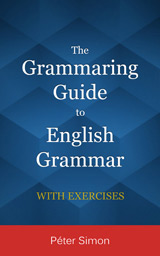The difference between times and tenses
Time is a concept which is related to our perception of reality. There are three times: past, present and future. Tense is a grammatical category which is marked by verb inflection and expresses when an event or action happens in the flow of time.
Strictly speaking, only two English tenses are marked by the inflection of the verb:
- past (talked)
- present (talks)
Other tenses are marked by auxiliaries (be, have):
- past continuous (was/were talking)
- past perfect (had talked)
- past perfect continuous (had been talking)
- present continuous (am/are/is talking)
- present perfect (have/has talked)
- present perfect continuous (have/has been talking)
As future time is expressed with the modal will + infinitive and not with inflection, the forms with will (will talk, will be talking, will have talked, will have been talking) are not considered to be tenses. However, for the sake of convenience, we refer to them as such throughout this book.
Therefore, the twelve basic tenses in English are:
| Simple | Continuous | Perfect | Perfect continuous | |
|---|---|---|---|---|
| Past | Past simple | Past continuous | Past perfect | Past perfect continuous |
| Present | Present simple | Present continuous | Present perfect | Present perfect continuous |
| Future | Future simple | Future continuous | Future perfect | Future perfect continuous |
Note that certain tenses in English may refer to a different time than that expressed by their names. For example, the present continuous tense may refer to either present or future time:
"What are you doing?" "I'm reading." (present reference)
"What are you doing on Wednesday evening?" "I'm visiting my grandma." (future reference)

